Exploring Metacognitive Experiences by Simulating Internal Decisions of Information Access
Abstract
1. Introduction
2. Theoretical Views
2.1. Glossary
- Attention as Internal Action (AIA): The understanding that a conscious experience is a volitional act of accessing information that has been previously generated automatically and unconsciously.
- Automatic Unconscious Process (AUP): A habitual cognitive process that gathers, transforms, and provides information without the awareness of the personality.
- Internal Action (IA): An act of volitional access to information that leads to a conscious experience of perceptual or mental imagery.
- Internal Agent: An actor that decides which information to access and generates an internal action.
- Two-Cause Internal Conjunction (TIC): A conscious experience that is due to the simultaneously occurring phenomena of an internal action and information provisioning by an Automatic Unconscious Process.
- General Internal Model of Attention (GIMA): A cognitive model whose purpose is to generally identify types of Two-Cause Internal Conjunction Phenomena and to represent relational knowledge between them.
- Stream of Incoming Sensory Information (SISI): The process of continuous and consecutive input of unprocessed sensory information.
- Sensory Event (SE): An occurrence in which information from the stream of incoming sensory information is packaged and ready for access by other processes.
2.2. Attention as Internal Action
2.2.1. Two-Cause Internal Conjunction
- A TIC phenomenon includes an imagery experience;
- An IA type is a brief conscious learning type;
- An AUP is a memory process that unconsciously retrieves, organizes, and/or generates information.
2.2.2. Knowledge Representation Framework
- The SISI: Denoted by a wavy line usually placed at the bottom of the representation.
- A Sensory Event (SE): Denoted with an acronym and a sequential number.
- An AUP type: An acronym or a name surrounded by a rectangle.
- An IA type: A semiotic symbol or an acronym surrounded by an ellipse.
- A motor plan execution: A rectangle with a cross in it.
- An unconscious information transition: An arrow.
- The link between two consecutively chosen AUPs: A dashed arrow.
- Reset of an AUP chain: Circular arrows representing a refresh.
2.2.3. Defining Data, Information, and Knowledge
2.2.4. Entitative and Linkative Knowledge Types
- Entitative type: The content is generated by an explicit IA and is represented by a knowledge entity.
- Linkative type: The content is generated by an implicit IA and is represented by one or several knowledge entities, linked to each other.
2.3. General Internal Model of Attention
2.3.1. Extending the Cognitive Architecture
- X is in layer (i) and Y is in layer (i);
- X is in layer (i) and Y is in layer (i + 1);
- X is in layer (i) and Y is in layer (i − 1);
- X is in any layer, Y is in layer (1), and a new significantly varying SE has occurred.
2.3.2. Model Components
- Regulation entitative IA: The process of approving or rejecting the veracity of a knowledge entity based on its relevance to an accepted goal. It is related to the control aspect of regulation.
- Regulation linkative IA: The process of generating a relevant but opposing knowledge entity in contrast to another, with the purpose of attaining an accepted goal.
3. Methods
3.1. Simulation System
3.1.1. Simulating Internal Decisions
- Learning MDP model (MDP-L): One for each goal that must be achieved in the external environment.
- Influencing MDP model (MDP-I): One for each L, with the purpose of simulating an internal demand for knowledge.
3.1.2. Simulated Task
- Reading the statement;
- Resolve (mentally) whether the statement is true or false (veracity-resolving);
- Execute a motor operation to click one of the buttons, depending on the decision.
- Reading: Perception entitative IA, perception linkative IA, conceptual entitative IA, and conceptual linkative IA.
- Veracity-resolving: Regulation entitative IA and regulation linkative IA.
- Button clicking: Procedural IA and deed IA.
3.1.3. Software Implementation
3.1.4. Simulation Parameters
- Count of simulated task executions (rounds): A single execution of the command can simulate several executions of the task.
- Statements for a task execution: A list of strings, each of which corresponds to a trial statement that is going to be processed in the loop of a single execution of the task.
- Reset MDP-L values: If set to true, all of the probability values of the three MDP-L models will be set to 0.5.
- Three MDP-I matrices: Corresponding to the three defined goals.
- Duration of a single cognitive cycle iteration: A single value, considered as average, was used for all the iterations. This value is used to measure the durations of the different simulated processes.
- IA for veracity-resolving: The IA, which, when selected during the veracity-resolving fulfillment, leads to exiting the function that reproduces this goal.
- Count of deed IA occurrences for the fulfillment of the clicking goal: When as many deed IAs are selected as specified by this parameter, the function responsible for reproducing the button-click goal fulfillment exits its code processing.
- Probability addition: Corresponds to the variable a from Equation (2).
3.2. Experimental Setup
- Parameter 1: Ten rounds per simulation.
- Parameter 2: A list of 10 strings representing the statements, which means that a single simulation involves the reproduction of 100 trials. The statement list contained one string with 20 words, one with 18, two with 17, and six with 19 words.
- Parameter 3: At the start of each of the three simulations, the MDP-L model values are reset to 0.5.
- Parameter 4: The MDP-I matrices are represented in Figure 8.
- Parameter 5: Average duration of a single cognitive cycle iteration was set to 327.87 (reasons below).
- Parameter 6: The IA that leads to completing a single veracity-resolving goal was set to be the regulation entitative IA for all simulations.
- Parameter 7: Two-deed IA executions were set to complete the button-clicking goal in all simulations.
- Parameter 8: This parameter was set to 0.02 for all simulations—on every simulated internal decision, the probability value corresponding to the state switch is increased by 0.02.
3.2.1. Software Code and Data Structures
- The average count of cognitive cycle iterations per trial;
- Data for the shortest trial;
- Data for the longest trial.
- Duration of the trial (in milliseconds);
- Count of cognitive cycle iterations in the trial;
- Count of words in the statement;
- Order of the IAs that were selected in the trial.
3.2.2. Used Software Tools
4. Results
4.1. Durations of Statement Verification Trials
4.2. Evolution of Probability Values
- Conceptual entitative—regulation linkative;
- Conceptual entitative—regulation entitative;
- Conceptual linkative—regulation linkative;
- Conceptual linkative—regulation entitative.
4.3. The Timing of Metacognitive Experiences
5. Discussion
5.1. Analyzing the Occurrences of Metacognitive Experiences
5.2. Comparison with Real Cognitive Effects
5.3. Limitations
5.4. System Applications
6. Conclusions
Author Contributions
Funding
Data Availability Statement
Conflicts of Interest
References
- Stanton, J.D.; Sebesta, A.J.; Dunlosky, J. Fostering Metacognition to Support Student Learning and Performance. CBE Life Sci. Educ. 2021, 20, fe3. [Google Scholar] [CrossRef]
- Ukov, T.; Tsochev, G. Reviewing a Model of Metacognition for Application in Cognitive Architecture Design. Systems 2025, 13, 177. [Google Scholar] [CrossRef]
- Efklides, A. The Role of Metacognitive Experiences in the Learning Process. Psicothema 2009, 21, 76–82. [Google Scholar]
- Madl, T.; Baars, B.J.; Franklin, S. The Timing of the Cognitive Cycle. PLoS ONE 2011, 6, e14803. [Google Scholar] [CrossRef]
- Ukov, T.; Tsochev, G.; Yoshinov, R. A Monitoring System for Measuring the Cognitive Cycle via a Continuous Reaction Time Task. Systems 2025, 13, 597. [Google Scholar] [CrossRef]
- Marks, D.F. The Action Cycle Theory of Perception and Mental Imagery. Vision 2023, 7, 12. [Google Scholar] [CrossRef]
- Franklin, S.; Madl, T.; D’Mello, S.; Snaider, J. LIDA: A Systems-Level Architecture for Cognition, Emotion, and Learning. IEEE Trans. Auton. Ment. Dev. 2014, 6, 19–41. [Google Scholar] [CrossRef]
- Ukov, T.G. Cognitive Monitoring of Learning as Experience Via a Semiotic Framework for System Models. SSRN 2025. [Google Scholar] [CrossRef]
- Tsochev, G.; Ukov, T. Explaining Crisis Situations via a Cognitive Model of Attention. Systems 2024, 12, 364. [Google Scholar] [CrossRef]
- Franklin, S.; Baars, B.J.; Ramamurthy, U.; Ventura, M. The Role of Consciousness in Memory. Memory 2005, 1, 38. [Google Scholar]
- Yeung, N.; Summerfield, C. Metacognition in Human Decision-Making: Confidence and Error Monitoring. Philos. Trans. R. Soc. Lond. B Biol. Sci. 2012, 367, 1310–1321. [Google Scholar] [CrossRef]
- Norman, D.A.; Shallice, T. Attention to Action: Willed and Automatic Control of Behavior BT-Consciousness and Self-Regulation. In Consciousness and Self-Regulation; Springer: Boston, MA, USA, 1986; Volume 4, pp. 1–14. [Google Scholar]
- Vallence, A.M.; Rurak, B.K.; Fujiyama, H.; Hammond, G.R. Covariation of the Amplitude and Latency of Motor Evoked Potentials Elicited by Transcranial Magnetic Stimulation in a Resting Hand Muscle. Exp. Brain Res. 2023, 241, 927–936. [Google Scholar] [CrossRef]
- Kugele, S.; Franklin, S. Learning in LIDA. Cogn. Syst. Res. 2021, 66, 176–200. [Google Scholar] [CrossRef]
- Gresch, D.; Boettcher, S.E.P.; van Ede, F.; Nobre, A.C. Shifting Attention between Perception and Working Memory. Cognition 2024, 245, 105731. [Google Scholar] [CrossRef] [PubMed]
- Jaffe, K. Infodynamics, a Review. Qeios 2024, 4, 1–22. [Google Scholar] [CrossRef]
- Cieslik, E.C.; Mueller, V.I.; Eickhoff, C.R.; Langner, R.; Eickhoff, S.B. Three Key Regions for Supervisory Attentional Control: Evidence from Neuroimaging Meta-Analyses. Neurosci. Biobehav. Rev. 2015, 48, 22–34. [Google Scholar] [CrossRef]
- Franklin, S.; Madl, T.; Strain, S.; Faghihi, U.; Dong, D.; Kugele, S.; Snaider, J.; Agrawal, P.; Chen, S. A LIDA Cognitive Model Tutorial. Biol. Inspired Cogn. Archit. 2016, 16, 105–130. [Google Scholar] [CrossRef]
- Markus, A.; Eviatar, Z. Competition in Context: Response Selection within the Supervisory Attentional System Model. Cogn. Neuropsychol. 2023, 40, 43–57. [Google Scholar] [CrossRef] [PubMed]
- Wixted, J.T. Atkinson and Shiffrin’s (1968) Influential Model Overshadowed Their Contemporary Theory of Human Memory. J. Mem. Lang. 2024, 136, 104471. [Google Scholar] [CrossRef]
- Baars, B.J.; Franklin, S. How Conscious Experience and Working Memory Interact. Trends Cogn. Sci. 2003, 7, 166–172. [Google Scholar] [CrossRef]
- Sun, R.; Slusarz, P.; Terry, C. The Interaction of the Explicit and the Implicit in Skill Learning: A Dual-Process Approach. Psychol. Rev. 2005, 112, 159–192. [Google Scholar] [CrossRef]
- Baars, B.J. The Global Workspace Theory of Consciousness: Predictions and Results. In The Blackwell Companion to Consciousness; Wiley: Hoboken, NJ, USA, 2017. [Google Scholar]
- Baars, B.J.; Gage, N.M. Consciousness and Attention. In Cognition, Brain, and Consciousness; Elsevier: Amsterdam, The Netherlands, 2010; pp. 238–303. [Google Scholar]
- Baars, B.J.; Franklin, S.; Ramsoy, T.Z. Global Workspace Dynamics: Cortical “Binding and Propagation” Enables Conscious Contents. Front. Psychol. 2013, 4, 200. [Google Scholar] [CrossRef]
- Zion, S.R.; Crum, A.J. Mindsets Matter: A New Framework for Harnessing the Placebo Effect in Modern Medicine. In International Review of Neurobiology; Elsevier: Amsterdam, The Netherlands, 2018; Volume 138, pp. 137–160. ISBN 978-0-12-814325-4. [Google Scholar]
- Wang, S.; Allen, R.J.; Fang, S.Y.; Li, P. Cross-Modal Working Memory Binding and L1-L2 Word Learning. Mem. Cogn. 2017, 45, 1371–1383. [Google Scholar] [CrossRef]
- Johnson-Laird, P.N. Mental Models and Cognitive Change. J. Cogn. Psychol. 2013, 25, 131–138. [Google Scholar] [CrossRef]
- Sun, R.; Zhang, X.; Mathews, R. Modeling Meta-Cognition in a Cognitive Architecture. Cogn. Syst. Res. 2006, 7, 327–338. [Google Scholar] [CrossRef]
- Sibert, C.; Hake, H.; Laird, J.; Lebiere, C.; Rosenbloom, P.; Stocco, A. The Role of The Basal Ganglia in the Human Cognitive Architecture: A Dynamic Causal Modeling Comparison Across Tasks and Individuals. In Proceedings of the 43rd Annual Meeting of the Cognitive Science Society: Comparative Cognition: Animal Minds, CogSci 2021, Vienna, Austria, 26–29 July 2021. [Google Scholar]
- Jones, S.J.; Laird, J.E. A Cognitive Architecture Theory of Anticipatory Thinking. AI Mag. 2023, 44, 155–164. [Google Scholar] [CrossRef]
- Ganesha, D.; Venkatamuni, V.M. Review on Cognitive Architectures. Indian J. Sci. Technol. 2017, 10, 1–8. [Google Scholar] [CrossRef]
- Boccaccio, F.M.; Pennisi, A.; Guerrera, C.S.; Platania, G.A.; Torre, V.; Varrasi, S.; Vezzosi, V.F.; Coco, F.; Castellano, S.; Pirrone, C. Mental Imagery between Cognition and Emotion: A Narrative Review. Psychiatry Int. 2024, 5, 697–717. [Google Scholar] [CrossRef]
- Baars, B.J. In the Theater of Consciousness; Oxford University Press: Oxford, UK, 1997; ISBN 978-0-19-510265-9. [Google Scholar]
- Parkins, E.J. Cerebellum and Cerebrum in Homeostatic Control and Cognition; Routledge: Oxfordshire, UK, 2021; ISBN 978-1-003-02460-6. [Google Scholar]
- Van Caenegem, E.E.; Moreno-Verdú, M.; Waltzing, B.M.; Hamoline, G.; McAteer, S.M.; Frahm, L.; Hardwick, R.M. Multisensory Approach in Mental Imagery: ALE Meta-Analyses Comparing Motor, Visual and Auditory Imagery. Neurosci. Biobehav. Rev. 2024, 167, 105902. [Google Scholar] [CrossRef]
- Damasio, A.R. Emotions and Feelings. In Feelings and Emotions; Cambridge University Press: Cambridge, UK, 2004; pp. 49–57. [Google Scholar]
- Bridge, H.; Harrold, S.; Holmes, E.A.; Stokes, M.; Kennard, C. Vivid Visual Mental Imagery in the Absence of the Primary Visual Cortex. J. Neurol. 2012, 259, 1062–1070. [Google Scholar] [CrossRef]
- van Otterlo, M.; Wiering, M. Reinforcement Learning and Markov Decision Processes. In Reinforcement Learning; Springer: Berlin/Heidelberg, Germany, 2012; pp. 3–42. [Google Scholar]
- Morais, G.; Yuji, E.; Costa, P.; Simões, A.; Gudwin, R.; Colombini, E. A General Framework for Reinforcement Learning in Cognitive Architectures. Cogn. Syst. Res. 2025, 91, 101354. [Google Scholar] [CrossRef]
- Aubret, A.; Matignon, L.; Hassas, S. An Information-Theoretic Perspective on Intrinsic Motivation in Reinforcement Learning: A Survey. Entropy 2023, 25, 327. [Google Scholar] [CrossRef]
- Job, S.; Tao, X.; Cai, T.; Li, L.; Xie, H.; Xu, C.; Yong, J. HebCGNN: Hebbian-Enabled Causal Classification Integrating Dynamic Impact Valuing. Knowl. Based Syst. 2025, 311, 113094. [Google Scholar] [CrossRef]
- Cui, X.; Jeter, C.B.; Yang, D.; Montague, P.R.; Eagleman, D.M. Vividness of Mental Imagery: Individual Variability Can Be Measured Objectively. Vision Res. 2007, 47, 474–478. [Google Scholar] [CrossRef]
- Sun, Y.; Xue, X.; Li, Z.; Ma, H.; Zhang, D. Association of Visual Conscious Experience Vividness with Human Cardiopulmonary Function. Stress Brain 2023, 3, 80–95. [Google Scholar] [CrossRef]
- Brysbaert, M. How Many Words Do We Read per Minute? A Review and Meta-Analysis of Reading Rate. J. Mem. Lang. 2019, 109, 104047. [Google Scholar] [CrossRef]
- Al-Shargie, F.; Tariq, U.; Mir, H.; Alawar, H.; Babiloni, F.; Al-Nashash, H. Vigilance Decrement and Enhancement Techniques: A Review. Brain Sci. 2019, 9, 178. [Google Scholar] [CrossRef]
- Neuwirt, H.; Eder, I.E.; Gauckler, P.; Horvath, L.; Koeck, S.; Noflatscher, M.; Schaefer, B.; Simeon, A.; Petzer, V.; Prodinger, W.M.; et al. Impact of Familiarity with the Format of the Exam on Performance in the OSCE of Undergraduate Medical Students—An Interventional Study. BMC Med. Educ. 2024, 24, 179. [Google Scholar] [CrossRef]
- Goldberg, T.E.; Harvey, P.D.; Wesnes, K.A.; Snyder, P.J.; Schneider, L.S. Practice Effects Due to Serial Cognitive Assessment: Implications for Preclinical Alzheimer’s Disease Randomized Controlled Trials. Alzheimer’s Dement. Diagn. Assess. Dis. Monit. 2015, 1, 103–111. [Google Scholar] [CrossRef]




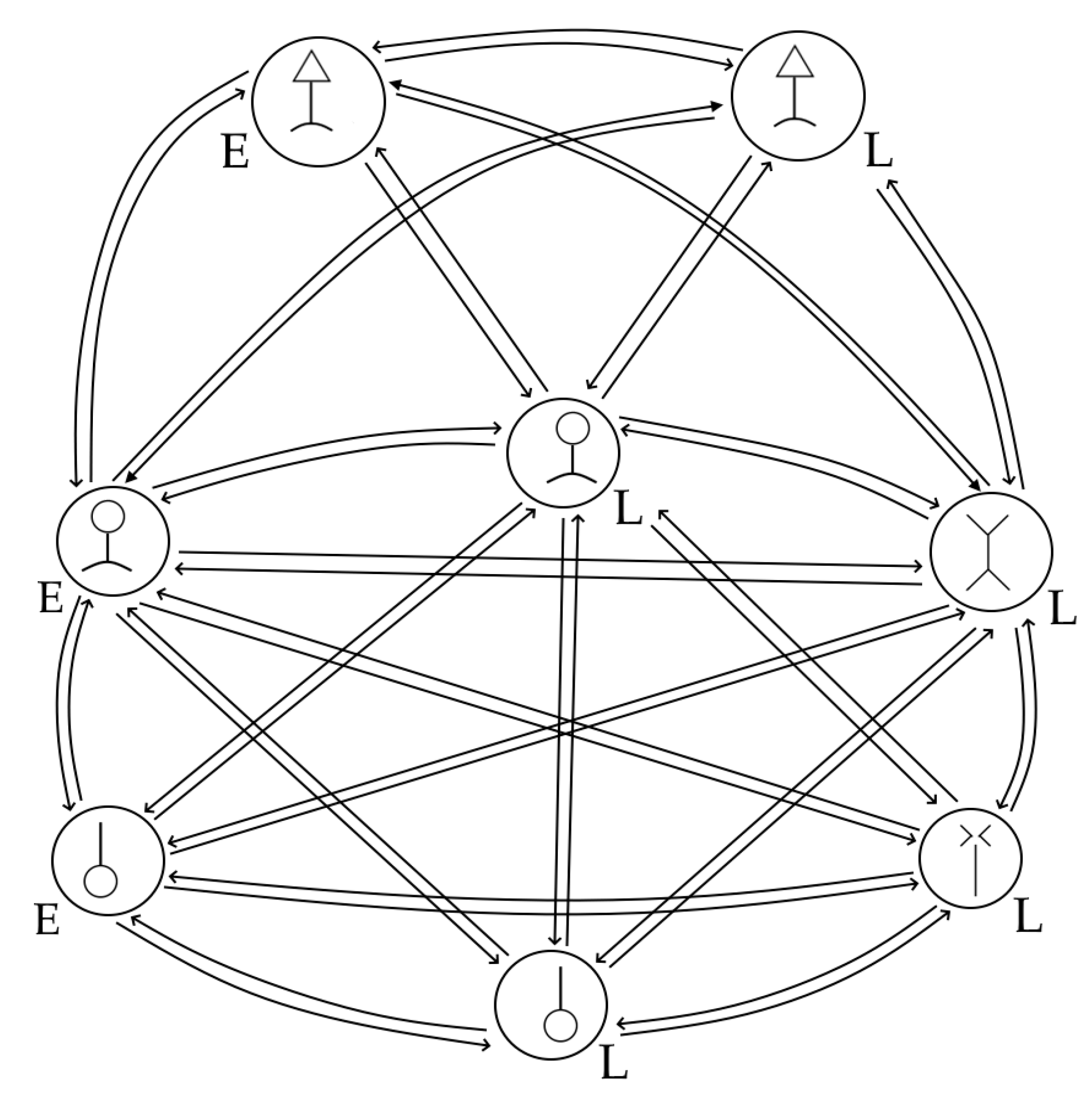
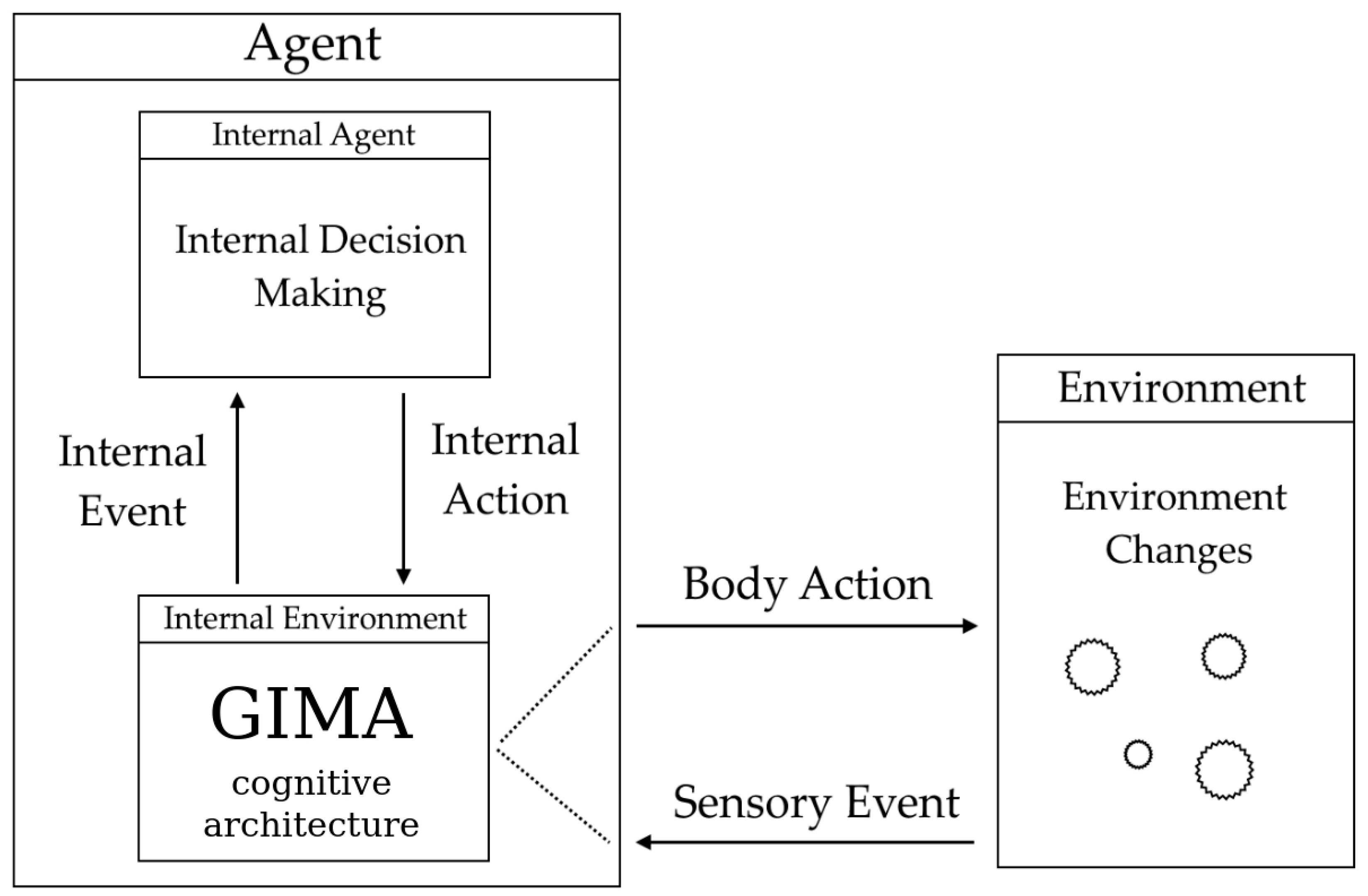



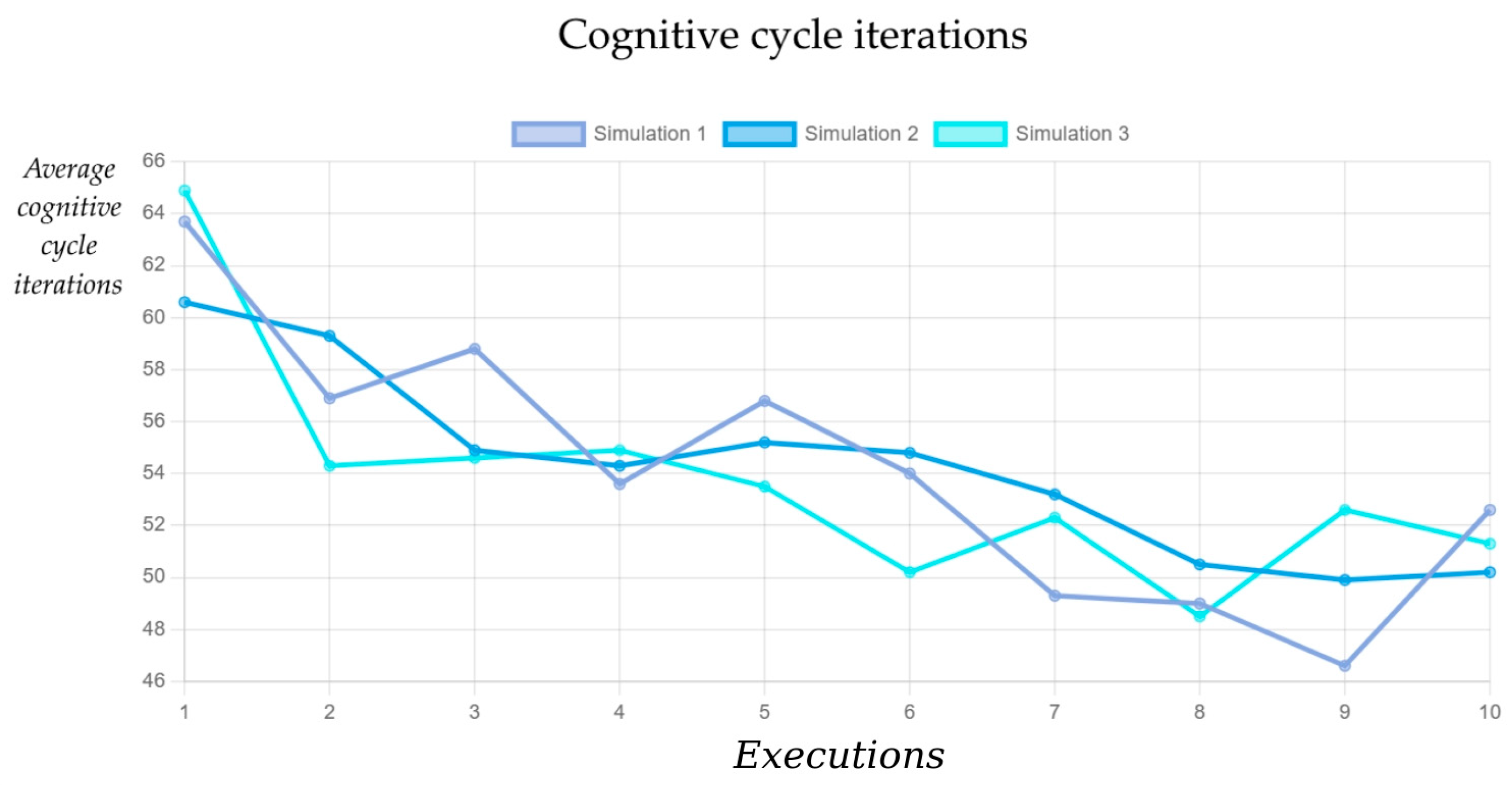
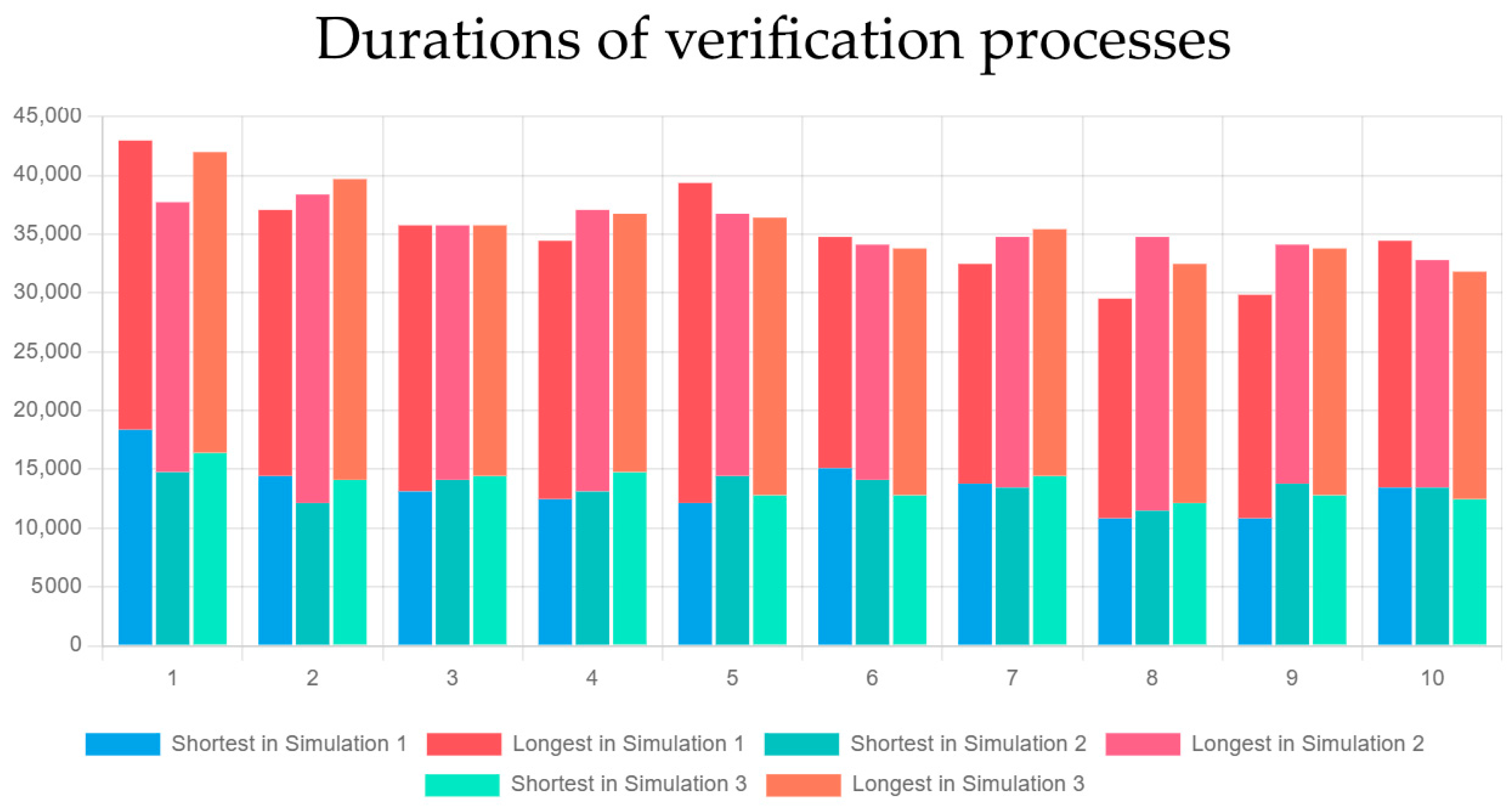

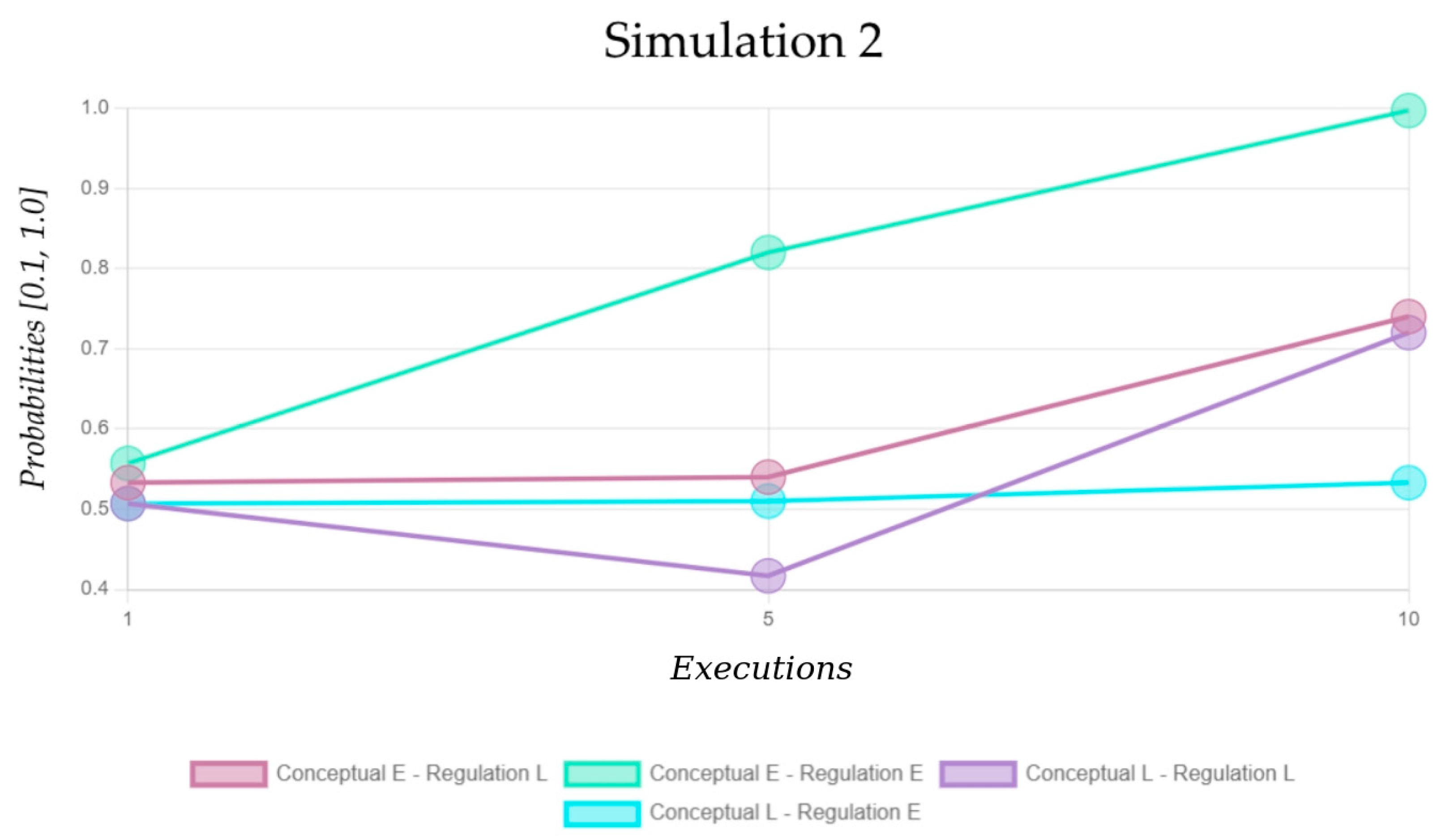


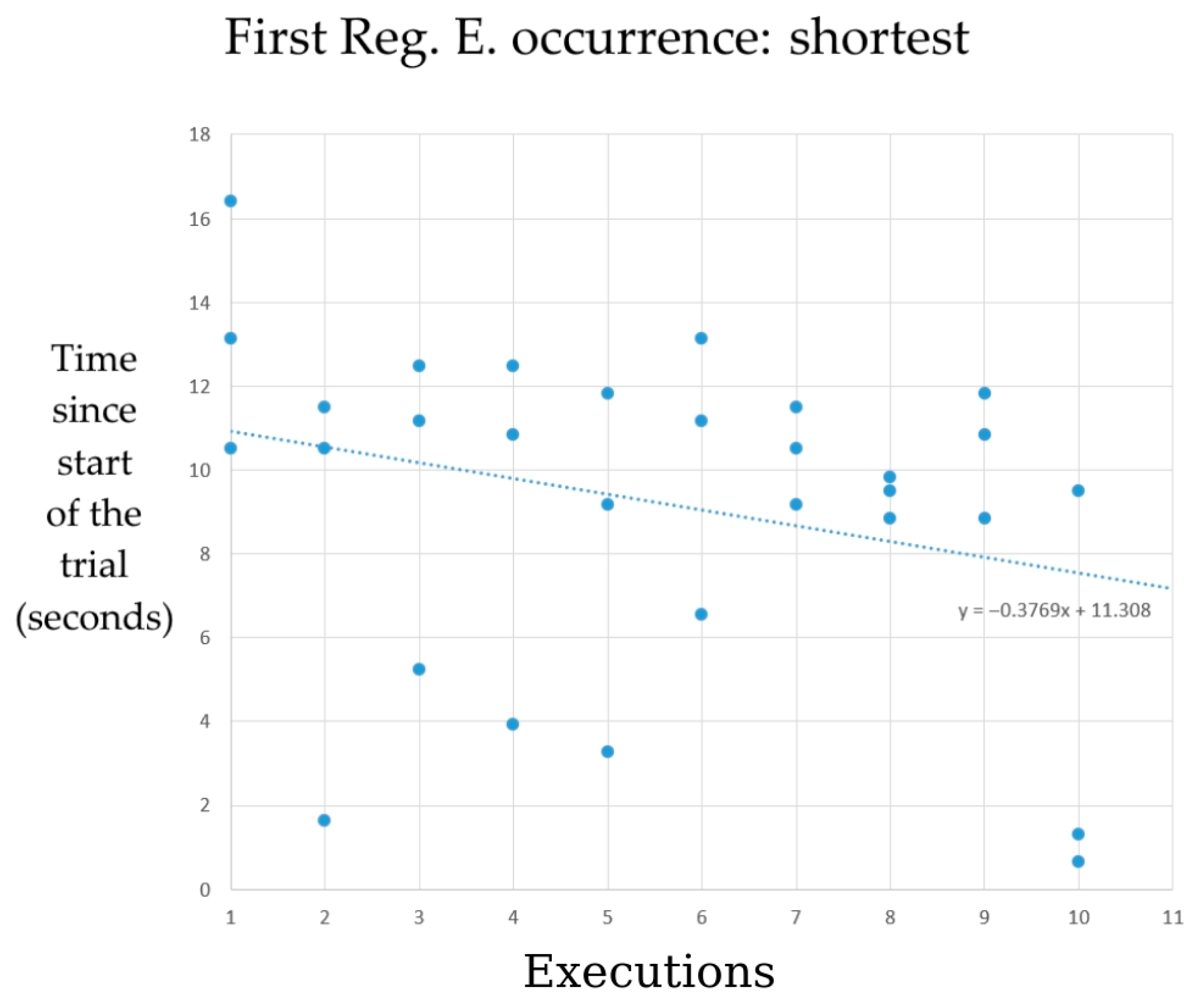
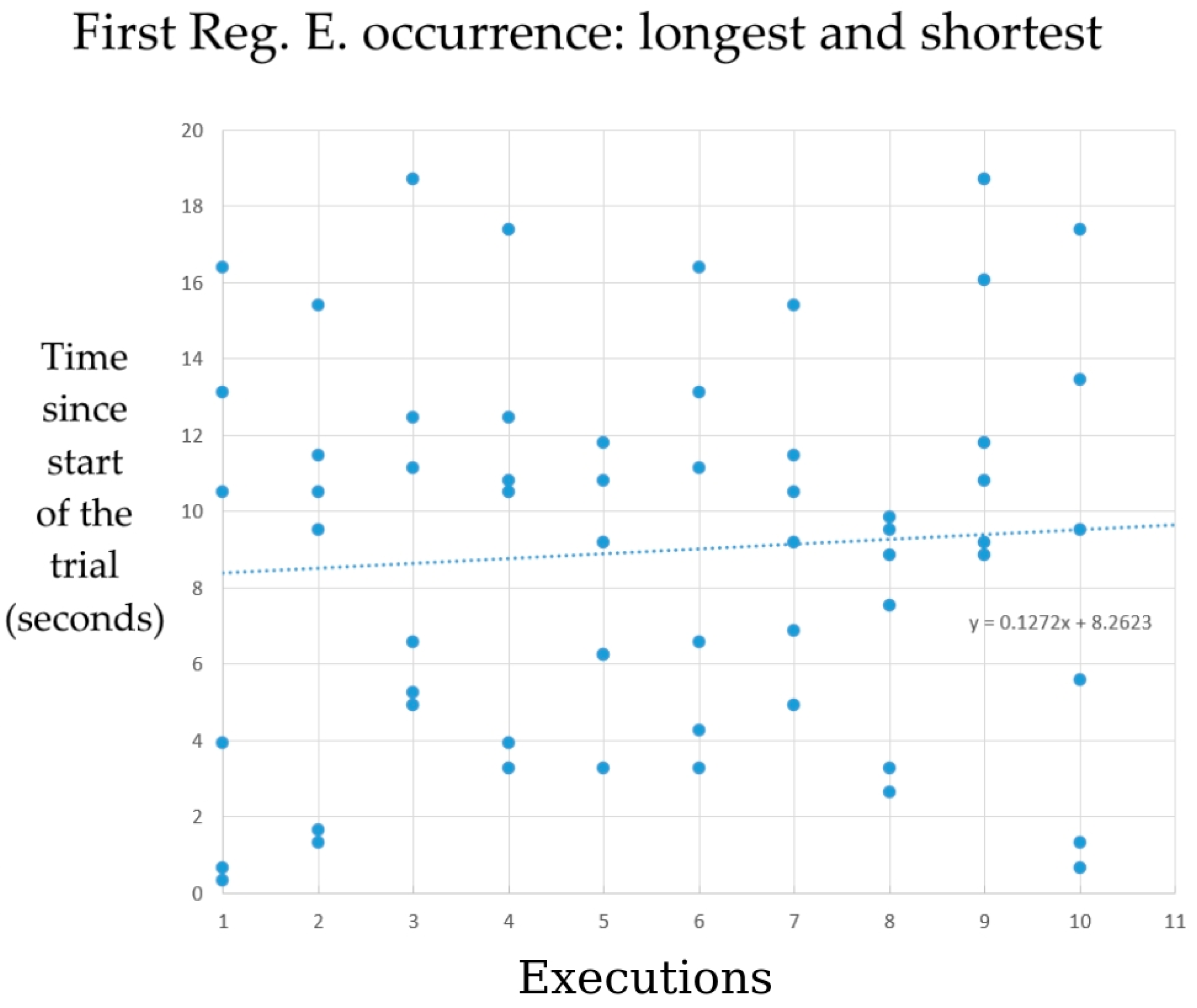
| Execution | Words | CCIs | Reg. E. Count | Reg. L. Count | First Reg. E. Occurrence Time | First Reg. L. Occurrence Time | Reading Time | First Reg. E. Time After Reading |
|---|---|---|---|---|---|---|---|---|
| 1 | 20 | 75 | 2 | 5 | 0.656 | 4.918 | 19.344 | 19.672 |
| 2 | 20 | 69 | 2 | 5 | 15.41 | 5.902 | 14.426 | 21.639 |
| 3 | 20 | 69 | 3 | 2 | 6.557 | 3.934 | 17.049 | 19.344 |
| 4 | 20 | 67 | 2 | 4 | 17.377 | 15.082 | 13.443 | 18.689 |
| 5 | 19 | 83 | 4 | 2 | 6.23 | 1.639 | 18.689 | 25.574 |
| 6 | 18 | 60 | 1 | 3 | 16.393 | 6.23 | 14.426 | 16.393 |
| 7 | 18 | 57 | 2 | 3 | 15.41 | 9.836 | 13.443 | 17.377 |
| 8 | 19 | 57 | 4 | 1 | 7.541 | 16.066 | 14.754 | 16.393 |
| 9 | 20 | 58 | 1 | 2 | 16.066 | 5.902 | 14.098 | 16.066 |
| 10 | 17 | 64 | 2 | 1 | 5.574 | 15.41 | 13.771 | 17.705 |
| Execution | Words | CCIs | Reg. E. Count | Reg. L. Count | First Reg. E. Occurrence Time | First Reg. L. Occurrence Time | Reading Time | First Reg. E. Time After Reading |
|---|---|---|---|---|---|---|---|---|
| 1 | 19 | 56 | 1 | 1 | 16.393 | 14.426 | 15.738 | 16.393 |
| 2 | 17 | 44 | 1 | 0 | 11.475 | — | 10.492 | 11.475 |
| 3 | 17 | 40 | 1 | 2 | 11.148 | 2.295 | 9.508 | 11.148 |
| 4 | 18 | 38 | 1 | 1 | 10.82 | 10.492 | 8.852 | 10.82 |
| 5 | 17 | 37 | 1 | 1 | 9.18 | 8.852 | 8.197 | 9.18 |
| 6 | 17 | 46 | 1 | 0 | 13.115 | — | 12.131 | 13.115 |
| 7 | 17 | 42 | 2 | 1 | 9.18 | 11.148 | 10.492 | 11.475 |
| 8 | 17 | 33 | 1 | 0 | 8.852 | — | 8.525 | 8.852 |
| 9 | 17 | 33 | 1 | 0 | 8.852 | — | 8.525 | 8.852 |
| 10 | 19 | 41 | 2 | 0 | 0.656 | — | 11.148 | 11.803 |
| Execution | Words | CCIs | Reg. E. Count | Reg. L. Count | First Reg. E. Occurrence Time | First Reg. L. Occurrence Time | Reading Time | First Reg. E. Time After Reading |
|---|---|---|---|---|---|---|---|---|
| 1 | 19 | 70 | 5 | 4 | 3.934 | 3.607 | 18.033 | 19.672 |
| 2 | 19 | 80 | 4 | 1 | 1.311 | 6.23 | 15.082 | 22.623 |
| 3 | 20 | 66 | 3 | 2 | 4.918 | 11.475 | 14.754 | 19.672 |
| 4 | 19 | 73 | 4 | 2 | 3.279 | 2.951 | 13.771 | 22.951 |
| 5 | 20 | 68 | 4 | 3 | 10.82 | 2.951 | 15.738 | 19.672 |
| 6 | 18 | 61 | 2 | 3 | 3.279 | 2.951 | 14.426 | 17.377 |
| 7 | 19 | 65 | 2 | 2 | 4.918 | 14.426 | 13.771 | 18.361 |
| 8 | 19 | 71 | 4 | 5 | 3.279 | 12.459 | 12.131 | 20.984 |
| 9 | 19 | 62 | 1 | 2 | 18.689 | 4.918 | 15.738 | 18.689 |
| 10 | 20 | 59 | 1 | 4 | 17.377 | 0.656 | 16.066 | 17.377 |
| Execution | Words | CCIs | Reg. E. Count | Reg. L. Count | First Reg. E. Occurrence Time | First Reg. L. Occurrence Time | Reading Time | First Reg. E. Time After Reading |
|---|---|---|---|---|---|---|---|---|
| 1 | 18 | 45 | 1 | 1 | 10.492 | 11.148 | 10.164 | 10.492 |
| 2 | 17 | 37 | 1 | 1 | 10.492 | 8.197 | 10.164 | 10.492 |
| 3 | 20 | 43 | 1 | 0 | 12.459 | — | 12.131 | 12.459 |
| 4 | 17 | 40 | 2 | 0 | 3.934 | — | 10.82 | 11.475 |
| 5 | 19 | 44 | 2 | 1 | 11.803 | 11.475 | 10.82 | 13.443 |
| 6 | 17 | 43 | 3 | 2 | 6.557 | 5.902 | 11.803 | 12.459 |
| 7 | 17 | 41 | 1 | 2 | 11.475 | 10.492 | 9.836 | 11.475 |
| 8 | 17 | 35 | 1 | 0 | 9.508 | — | 8.197 | 9.508 |
| 9 | 17 | 42 | 1 | 0 | 11.803 | — | 11.148 | 11.803 |
| 10 | 19 | 41 | 2 | 1 | 1.311 | 12.459 | 10.82 | 11.148 |
| Execution | Words | CCIs | Reg. E. Count | Reg. L. Count | First Reg. E. Occurrence Time | First Reg. L. Occurrence Time | Reading Time | First Reg. E. Time After Reading |
|---|---|---|---|---|---|---|---|---|
| 1 | 17 | 78 | 4 | 5 | 0.328 | 0.656 | 17.049 | 22.295 |
| 2 | 20 | 78 | 4 | 3 | 9.508 | 17.705 | 14.098 | 23.279 |
| 3 | 20 | 65 | 1 | 2 | 18.689 | 14.098 | 11.475 | 18.689 |
| 4 | 19 | 67 | 2 | 3 | 10.492 | 2.295 | 19.016 | 19.672 |
| 5 | 19 | 72 | 2 | 6 | 6.23 | 13.443 | 12.459 | 19.672 |
| 6 | 19 | 64 | 4 | 5 | 4.262 | 3.934 | 17.705 | 18.689 |
| 7 | 17 | 64 | 5 | 3 | 6.885 | 2.623 | 16.066 | 17.377 |
| 8 | 19 | 62 | 3 | 3 | 2.623 | 2.295 | 14.426 | 19.016 |
| 9 | 19 | 64 | 3 | 3 | 9.18 | 14.754 | 13.115 | 18.033 |
| 10 | 20 | 59 | 2 | 5 | 13.443 | 12.131 | 11.803 | 16.393 |
| Execution | Words | CCIs | Reg. E. Count | Reg. L. Count | First Reg. E. Occurrence Time | First Reg. L. Occurrence Time | Reading Time | First Reg. E. Time After Reading |
|---|---|---|---|---|---|---|---|---|
| 1 | 17 | 50 | 1 | 4 | 13.115 | 4.918 | 11.803 | 13.115 |
| 2 | 18 | 43 | 2 | 0 | 1.639 | — | 10.164 | 10.82 |
| 3 | 17 | 44 | 2 | 1 | 5.246 | 5.574 | 10.82 | 11.148 |
| 4 | 20 | 45 | 1 | 1 | 12.459 | 4.262 | 12.131 | 12.459 |
| 5 | 17 | 39 | 2 | 1 | 3.279 | 11.148 | 9.836 | 10.82 |
| 6 | 20 | 39 | 1 | 0 | 11.148 | — | 10.492 | 11.148 |
| 7 | 18 | 44 | 2 | 1 | 10.492 | 9.18 | 10.164 | 11.148 |
| 8 | 19 | 37 | 2 | 0 | 9.836 | — | 9.508 | 10.492 |
| 9 | 17 | 39 | 1 | 1 | 10.82 | 11.148 | 10.492 | 10.82 |
| 10 | 19 | 38 | 2 | 1 | 9.508 | 9.18 | 8.525 | 11.475 |
Disclaimer/Publisher’s Note: The statements, opinions and data contained in all publications are solely those of the individual author(s) and contributor(s) and not of MDPI and/or the editor(s). MDPI and/or the editor(s) disclaim responsibility for any injury to people or property resulting from any ideas, methods, instructions or products referred to in the content. |
© 2025 by the authors. Licensee MDPI, Basel, Switzerland. This article is an open access article distributed under the terms and conditions of the Creative Commons Attribution (CC BY) license (https://creativecommons.org/licenses/by/4.0/).
Share and Cite
Ukov, T.; Tsochev, G. Exploring Metacognitive Experiences by Simulating Internal Decisions of Information Access. Systems 2025, 13, 982. https://doi.org/10.3390/systems13110982
Ukov T, Tsochev G. Exploring Metacognitive Experiences by Simulating Internal Decisions of Information Access. Systems. 2025; 13(11):982. https://doi.org/10.3390/systems13110982
Chicago/Turabian StyleUkov, Teodor, and Georgi Tsochev. 2025. "Exploring Metacognitive Experiences by Simulating Internal Decisions of Information Access" Systems 13, no. 11: 982. https://doi.org/10.3390/systems13110982
APA StyleUkov, T., & Tsochev, G. (2025). Exploring Metacognitive Experiences by Simulating Internal Decisions of Information Access. Systems, 13(11), 982. https://doi.org/10.3390/systems13110982






